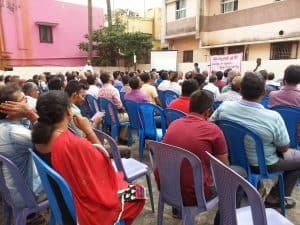Imagine a beautiful lake in your neighbourhood that is not just a lifeline in terms of freshwater for the city, but could also be a seat of leisure for you and your kids at the end of a tiring day, and home to a thriving, aquatic ecosystem. Instead it becomes, over decades, a disposal site for untreated sewage, marred by excessive encroachment and irresponsible, damaging activities like washing of clothes, cars etc. It is rarely desilted, and there is no proper outlet for the excess water leading to flooding of roads around it every rainy season.
That is a scenario that residents around Porur Lake will quickly identify with, which is why NGO Arappor Iyakkam, armed with findings from a recent audit of the waterbody and overwhelming support from the Porur chapter, decided to focus on restoration of the lake which has shrunk from over 450 acres to less than 250 acres.
Earlier in May this year, a 10-point charter (see table below) had been prepared and submitted to the Tiruvellore Collector. However, this resulted in feeble action on the ground from the government, following which Arappor decided to create a people’s movement by educating the people on the issues found during the audits and the politics behind restoring our water bodies.
|
10-POINT CHARTER TO SAVE PORUR LAKE BY ARAPPOR IYAKKAM
|
Arappor had also given a call to NGOs, movements and individuals working for the welfare and restoration of the Porur Lake to gather on July 9, 2017. With over 250 people participating from Porur and Ramapuram areas, the venue was packed to the gates.

People at the event organised by Arappor Iyakkam to spread awareness about Porur Lake. Pic: Prashanth Goutham
What obstructs restoration?
“Will anyone here not want to save Porur lake?”
The opening question from Jayaram Venkatesan, Convenor of Arappor, drew a surprised silence from the audience, many among whom wondered why it arose, till he himself explained: “The very fact that 100% of the people here want the lake to be revived is testimony that we are working towards a positive change. Then, why are we having to face so much difficulty even to organize this event?”
Venkatesan was alluding to the fact that the meeting venue had to be shifted from the originally planned location on the main road to the inner parking area due to police pressure. “If there is an encroachment and we organise a protest against it, the police force do not provide necessary permissions, but they readily protect the encroachers. The venue of this meeting had to be shifted just 30 minutes prior to its start, due to pressure from them; why? We are only trying to save the Porur Lake, not sell Gutkha,” he demanded to know, referring to the recent scandal over the sale of the banned tobacco item. “Saving the Porur Lake is difficult, but selling banned Gutkha is easy and this is the politics that we all need to know and understand,” he retorted.
When Venkatesan talks of encroachers being protected, he refers to people with political clout, real estate mafia or big organizations which have already eaten into more than 50% of the lake area. For example, he cited how the Sri Ramachandra Education and Health Trust has received support from the government itself for its claims of land inside the lake.
“Everyone claims that they want the waterbodies to be restored, so why is there no progress? What is stopping anyone from acting? The answer lies in people behind the scenes – political party workers, commercial vested interests who stand to benefit from its erosion,” said Venkatesan. In his view, the power that these selected vested interests can wield is far greater than the pressure that we as common people can exert. Politicians and government executives such as IAS, IPS are all agents of these invisible vested interests and that sums up the politics behind urban water bodies.
Given the 300 plus waterbodies in and around Chennai is accumulating over 1000 MLD of sewage everyday, while garbage, construction debris and even sewage transported in tankers is dumped into these at ease, it is difficult to deny that the government stands guilty as a principal offender in this space.
Venkatesan also pointed to a serious error made by the National Water Policy 2012 when it listed water as an “Economic Good” instead of a “fundamental right.” This resulted in commoditization of water leading to scandalous extraction by private companies and subsequent sale of the same to people for a price. This provision (of treating water as economic good) is intended for the privatization of water-related services, which is anti-people.
Where do the crores go?
Around Rs 100 crores were allocated to desilting of water bodies through the Kudimaramathu scheme in March but was said to have been spent within 18 days. In its recent audit of six waterbodies in Kanchipuram district, Arappor found that only one had an insignificantly small trench which was dug.
Drilling deeper into the mechanics of this allocation, it is noticed that Rs 100 crores for 1512 waterbodies translates to less than Rs 9 lakhs/site, which makes it easier to do away with tenders and issue contracts as per their whims and fancies. Immediately after this, another 300 crores were allocated under the same scheme.
Arappor emphasises that there is no one way or method to fight against the non-electoral politics of these forces, it needs to be a strong people’s movement. Common people must fight for the cause of Porur Lake, without focusing on who organized it. The 10-point charter in this regard forms a flexible base. Peaceful agitations and legal battles are some of the measures that could be adopted as a first step in this long journey.